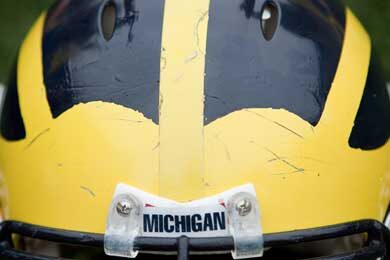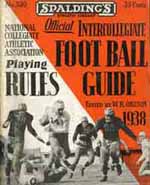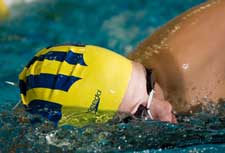“Being a part of this school and this tradition—and wearing these helmets—that’s why I came here.” New England Patriots Quarterback Tom Brady, speaking with Team 134 in August 2013
Crisler, the unlikely designer

Crisler favored the FH5 model, with three straps running front to back. (Image courtesy of U-M’s Bentley Historical Library.)
He won a national championship in 1947, he changed the game forever with the platoon system in the late 1940s, and he shaped college football by serving on the NCAA rules committee for more than two decades before he retired in 1968. Yet former Michigan football coach and athletic director Fritz Crisler might be best remembered for designing the Wolverines’ distinctive “winged helmet,” the most recognizable headgear in college football.
But here’s a dirty little secret: Crisler first designed the winged helmet at Princeton, not Michigan, and brought it with him.
Crisler’s winged helmet design took advantage of features of a helmet advertised in the 1937 A.G. Spalding & Bros. Company edition of the Official Intercollegiate Football Guide.
Back then the headgear looked like the leather biking helmets favored by today’s Tour de France riders. They typically consisted of a leather bowl with an extra pad to protect the forehead, from which three strips of padding ran to the back—all of it painted black. To help his Princeton quarterback identify his receivers downfield and give his team a little style in the process, Crisler simply painted the extra padding Princeton orange and—voila!—the winged helmet was born.When Crisler came to Ann Arbor in 1938, he brought the winged helmet with him. (The Princeton Tigers dropped the design in 1937, a year before Crisler left, and only started using it again recently—no doubt inspired by Michigan’s success in popularizing it.) The University of Delaware Blue Hens started wearing the design when former Michigan fullback Dave Nelson became the head coach there in 1951. Unlike the Tigers, however, the Hens have continued to wear the Crisler design to this day.
Flying high

In this photo from a later game, Kromer leads the blocking for classmate and “Touchdown Twin” Tom Harmon (98). (Image courtesy of U-M’s Bentley Historical Library.)
Crisler’s first team went on to compile a 6-1-1 record and tie for second in the conference. Whether attributable to the new helmet or not, the passing game improved significantly over 1937’s final statistics; total yardage nearly doubled, interceptions were cut nearly in half and completion percentage was up by nine percent.
Passion statement
Since the design’s introduction in 1938, the shape of the wing has been smoothed out and the stripes now extend all the way to the base of the helmet.
There is no question that the unique helmet has been Michigan’s calling card since its debut 75 years ago. The design has come to symbolize so much power, discipline, and excellence that after the Wolverine hockey team adopted it on the eve of the 1989 CCHA playoffs, other teams, including men’s lacrosse, eventually followed. The catchers for the baseball and softball teams and field hockey goalies proudly wear the winged design on their helmets. The women’s rowing team also has adopted the winged logo. The swimming team even wore the familiar image on its racing caps for a few years.
If Crisler were to return to Michigan Stadium, Yost Arena, Fisher Field, or Alumni Field, he would immediately recognize his handiwork. He would be pleased to discover that Michigan coaches can’t count how many times they’ve heard recruits say the winged helmet was first thing they liked about Michigan. Some, including football’s all-time rushing leader, Jamie Morris, even claim their desire to wear the famous winged helmet was their motive to come to Ann Arbor.“I had three older brothers play for Syracuse (including Joe, who later starred for the New York Giants), but I just loved Michigan’s helmets,” Morris says. “That’s the reason why I came here. That, and the little guy storming and down the sidelines,” he adds, referring to his coach, Bo Schembechler. Tom Brady, quarterback for the New England Patriots, echoed that sentiment in August when he visited the team lockerroom. (See video of Brady with Team 134.)

Advances in design and engineering, some based on research done at U-M, have greatly increased the protective capabilities of the modern helmet while maintaining the iconic design. (Photo: Eric Bronson, Michigan Photography)
Michigan’s rivals aren’t quite as fond of the helmet design. When the Wolverines gather under the tunnel before games, the maize strips on their dark helmets make them look like a bunch of bees from the stands, ready to attack anything in its path—an effect that’s amplified when they charge through the “M Go Blue” banner and jump on top of each other at the other end of the field. Any opposing player can tell you that’s one of the scariest sights in college football. Some visiting coaches won’t even let their players watch.
The effect can be so intimidating that at times several Michigan opponents, including Notre Dame and Indiana, have taken to taping the design over their helmets during practice to lessen the shock of seeing the Maize and Blue helmets come flying out of the tunnel, and setting up across the line. But anyone who’s seen Michigan’s helmet can tell you that it’s definitely not the same as the real thing.
“Everybody else has regular helmets,” says Bobby Hayes, class of ’98. “No one else has helmets like we do. That helmet, that’s Michigan.”
Gregory Kinney, archivist at U-M’s Bentley Historical Library, contributed to this story. Find more information on Michigan’s winged helmet. The Bentley also features a visual timeline of the Wolverine football uniform from 1900-1950.






